Abstract
The onboarding system occupies an important place in working with personnel. The onboarding process in the new work team has gender differences. The study considers gender differences of the onboarding process of the company. In the course of the study, it was revealed that there are differences in onboarding men and women in a new team. It has been established that women take part in training programs with pleasure and are aimed at mastering new information. They expect stability and good working conditions and the possibility of independence in work. However, they have difficulties with the structure of the company and understanding of their job responsibilities. They adapt longer to the new work environment and later begin to independently perform work. Men better understand the structure of the company, quickly begin to navigate the new workplace and independently fulfill their duties. They have a positive attitude towards training programs, but try not to be distracted from work, and they also gradually establish contacts with new colleagues. Recommendations have been developed for the onboarding program taking into account gender differences, which should be taken into account by mentors. Thus, in the onboarding program, one must take into account the fact that men and women interact in different ways with people around them, react differently to work situations, and get used to new conditions in different ways.
Keywords: Genderwomanfemale professional mentalityonboarding
Introduction
The onboarding system occupies an important place in working with personnel. The onboarding period is the most important stage in which a new employee joins the team, and the effectiveness of his work in the company will depend on the success of acquaintance with his new environment. Many candidates who left immediately after the probationary period often decided to do so in the first weeks of work. Therefore, the onboarding system is an important element of the personnel management system.
Problem Statement
Moving to a new job is always a stressful situation. During onboarding, men and women react differently to a new environment. The onboarding process in the new team has a number of gender differences (Scalise et al., 2019). In particular, difficulties in onboarding men and women appear at different stages. So, it is difficult for women to go to the stage of direct work; they often prolong the stage of general orientation and acquaintance with the company, its norms and culture. Men, on the contrary, immediately begin to work and “skip over”, in their opinion, “not a very important stage of acquaintance” (Sanakina & Sillaste, 2017). Thus, gender mainstreaming needs to be taken into account in onboarding programs.
Research Questions
The research questions are the following:
How are gender differences manifested in the onboarding process of the company?
How to take into account gender differences in the onboarding program of the company?
Purpose of the Study
The purpose of this study is to analyze the existing gender differences in the onboarding process of the company and highlight the main ones. It is also important to finalize the onboarding program of the company, taking into account gender differences (for women).
Research Methods
Hypothesis development
Onboarding difficulties
Women have difficulties in the areas of organizational and professional onboarding. They face the least difficulties in socio-psychological onboarding.
Priorities at the new place of work
In the course of the onboarding period, the opportunity to be engage in professional skills is very important for men. As for women, they need stability, good working conditions and a good team.
Findings
Gender differences in employment in Russia are inseparable from the issue of national mentality. Historically, women had to farm and raise children, while the man was the “breadwinner”. Women's professional mentality includes such attitudes. Although, according to studies, most respondents believe that a woman should combine work and family responsibilities (Busygina & Shtrikov, 2019).
There is no certainty in the question - who better adapts to a particular field of activity - men or women. Men and women interact with others in different ways and react differently to working situations, get used to new conditions differently (Bullough, Moore, & Kalafatoglu, 2017).
There are four areas in the onboarding system: organizational; socio-psychological; professional; psycho-physiological. The onboarding process can be divided into four stages:
Stage 1. Common orientation. At this stage, the new employee is introduced to his new responsibilities, corporate rules, traditions, work schedules, etc.
Stage 2. Enter office. At this stage, the new employee gets acquainted with the functions and goals of the unit, his own goals. There is an involvement in interpersonal relationships with colleagues.
Stage 3. Effective orientation. At this stage, the employee applies existing or acquired knowledge, receives feedback from the leader or mentor.
Stage 4. Functioning. This stage of onboarding is final. It is characterized, first of all, by overcoming interpersonal and production problems and transition to stable work.
The authors conducted a study in which employees of the Brewing Company (PC) in the amount of 63 people (30 men) and (33 women) took part. The age of respondents is 22-45 years old. Based on responses of respondents, we identified the following aspects of onboarding (Figures
Behavioral rules at work (Figure
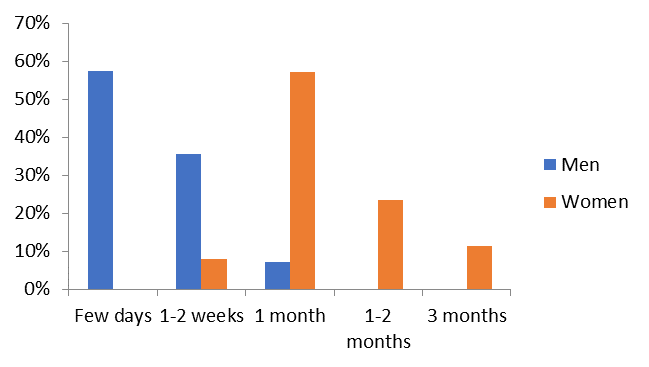
-
Establishing contact with the team (Figure
02 ). 42.9% of men and 45.1% of women gradually establish contacts in the new team. 33.1% of men and 45.1% of women consider integration into the team an important process and find mutual understanding with new colleagues within one week. 23.8% of men and 9.8% of women do not want to be distracted from work and they need more than one month to establish communications with new colleagues.
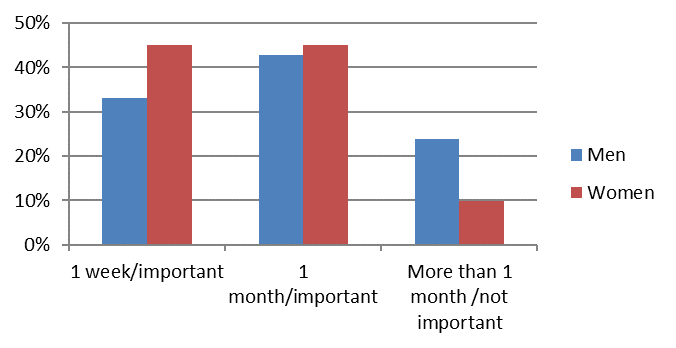
-
Adapt to a new working environment (Figure
03 ). 85.6% of men 24.2% of women adapt to the new work environment within a week. 33.2% of women and 14.3% of men - within 2-3 weeks; 11.4% of women - within a month and 31.1% of women - in 2-3 months.
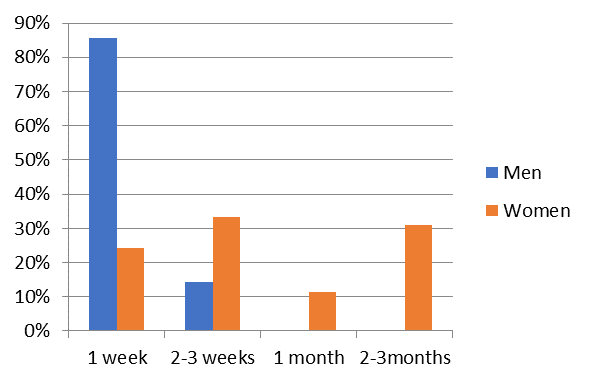
-
Independence in performing duties (Figure
04 ). 72.3% of men and 44.2% of women independently begin to perform duties in a week. About 32.5% of women and 16.2% of men - in a month, about 23.2% of women and 11.4% of men - in 2-3 months.
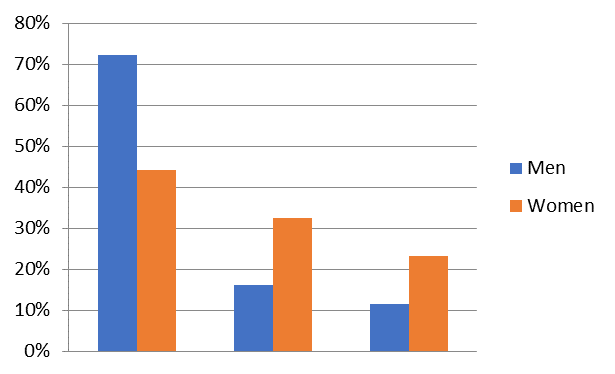
-
Difficulties at the beginning of work (Figure
05 ). 56.9% of men and 34.8% of women face difficulties working with new colleagues. 29.3% of men and 34.8% of women have difficulties with duties. 46.1% of women have difficulties with the company’s structure and 13.2% of men have difficulties with a new situation.
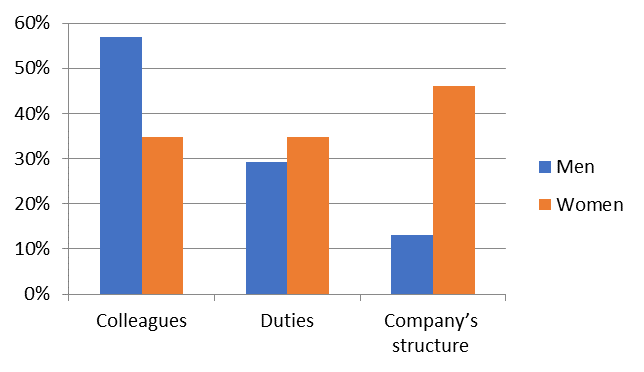
-
Attitude to training programs (TP) during the onboarding period (Figure
06 ). 56.9% of men and 65.5% of women say that training programs during onboarding help them to get comfortable at a new place of work. About 34% of women and 14% of men would like to receive training, since they did not have it, and 29.1% of men and 6% of women believe that training is not necessary and distracts from work. 14% of men and 12% of women say that training programs are necessary for entering a post. Also, 92.4% of women and 86% of men agree with the support from a personal mentor during the onboarding period.
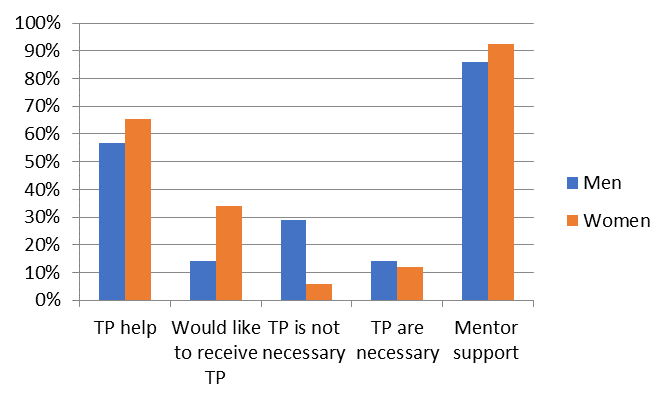
-
Priorities in work (Figure
07 ). As for important aspects of work, 72% of men and 16% of women include the opportunity to do what they love, 58.1% and 16% - self-expression, 43% and 45.3% - a good team, 14.1% and 56 % - working conditions, 23% and 21.4% - independence and stability.
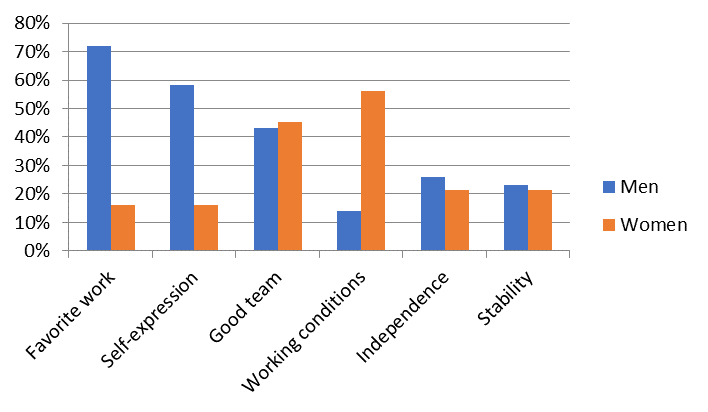
Thus, we can talk about differences in onboarding men and women. For women, socio-psychological onboarding is a priority. Women adapt to the new team quicker than men; they are ready to communicate and create new connections. Women take part in training programs with pleasure and are aimed at mastering new information. They expect stability and good working conditions and the possibility of independence in work. However, they have difficulties with the structure of the company and understanding of their job responsibilities. They adapt to the new work environment later than men and later begin to independently perform work.
Men better understand the structure of the company, quickly begin to navigate the new workplace and independently fulfill their duties. They have a positive attitude towards training programs, but try not to be distracted from work, and also gradually establish contacts with new colleagues.
Thus, the study confirmed the results of previous studies that women attach secondary importance to the socio-psychological aspects of onboarding, and men - professionally-active ones. Mentors should take into account identified factors in their work. Note that the results obtained, of course, do not exclude an individual approach.
Proposals for improving the onboarding process in the Brewing Company are formulated taking into account gender differences. The document regulating the onboarding process is the “Regulation on onboarding new employees” and, as a result, the onboarding program for new employees was developed.
Let us consider the Regulation on onboarding new employees of the Brewing Company. One of the sections is about a mentoring system, which involves helping new employees in their onboarding. The main tasks of mentoring include transferring professional skills to a novice, accelerating his integration into the organization and the team, and creating employee independence. The appointment of a mentor is done by the head of the unit and the head of the personnel management service. The head evaluates his subordinates for compliance with the requirements set forth in the Regulation on onboarding new employees, and provides candidates for approval to the head of the personnel management service.
Further, the Regulation defines the process of organizing mentoring. It establishes to which categories of employees mentoring will be applied, as well as the duration of mentoring, cases of replacing the mentor and the interaction of the mentor with other employees of the organization. Note that no more than three employees should be assigned to one mentor. The minimum period of mentoring coincides with the minimum period of onboarding - three months (this period is defined in the personnel onboarding program). The maximum period is one year. The period of mentoring is determined by a joint decision by the head of the personnel management service and the head of the unit. During the onboarding process, the period of mentoring can be reduced at the discretion of the head of the personnel management service and the head of the unit, and onboarding is completed ahead of schedule.
The Regulation also defines the rights and obligations of both the mentor and the new employee. The main duties of the mentor include: assistance to a beginner in his professional activity, assistance in integration into the team; participation in the development of the plan and tasks for onboarding, control and evaluation of the beginner and the provision of feedback on onboarding to the personnel management service and manager. The main responsibilities of the trainee include: implementing the onboarding plan, following the instructions of the mentor, providing reports on his work.
Mentors evaluate the work of their interns. The evaluation process and assessment criteria are defined in the clause of the Regulation “Analysis of the intern's work during the onboarding period”. Assessment is divided into intermediate and final. For the final assessment, the mentor prepares a report on the results of the employee’s onboarding and sends it to the leader, who decides on the completion of the mentoring period.
Taking into account difficulties encountered by women during the onboarding period, it is proposed to supplement the onboarding program with the following activities:
1. Access to the organization’s premises. A new company employee needs to overcome the administrative barrier as quickly as possible. These include: passes to the premises of the organization, to different floors of the building, keys, cards, coupons and digital codes, entering data on a new employee in all the necessary lists. A number of studies show the dependence of job satisfaction on access to the organization’s premises and auxiliary equipment (Brunia, De Been, & van der Voordt, 2016; Danielsson & Theorell, 2019; Volodina, 2009).
2. The internal routine. Acquaintance with the rules of administrative interaction: where to take stationery, how to use office equipment and whom to contact if you need to get a trial batch of products from production.
3. The workplace. The territory of the employee’s personal workspace must correspond to the profile of the position. For example, an accountant will need a large and wide table for working with folders and documents, a cabinet or a cabinet-archiver. For a designer, the diagonal of the monitor and monitor resolution are important. Also, the mentor needs to test the operation of all systems: he has to check if the printer is connected, if the Internet is working and if all the necessary programs are installed. This factor affects the loyalty of the organization’s personnel (Peterson, Kara, Fanimokun, & Smith, 2019).
4. Dress code (Rippin, Shortt, & Warren, 2016). The dress code can be regulated, or it can be unofficial, not fixed in formal documents. It is necessary to tactfully explain these rules to the new employee. It is possible to pay attention to certain personal tastes and preferences in the clothes of the head, if any.
5. Acquaintance with the company. It is important to introduce a new person to the team, briefly talk about what he will do. And introduce the new employee personally with each employee from her department. An informal meeting of the department is preferable to an individual presentation of employees to each other. Within the organization, all employees need to send a virtual business card to a new employee using the intranet internal information system or mailing to corporate addresses.
Mentors are interested in the successful onboarding of their subordinates, as the effectiveness of their work is also evaluated. Assessment of mentors is carried out using the following indicators:
1. The number of trainees attached to the mentor who successfully completed onboarding in the reporting period.
2. The percentage of employees who successfully completed onboarding under the guidance of the mentor. The indicator is calculated as the ratio of the number of trainees who successfully completed onboarding under the supervision of the mentor to the total number of trainees attached to this mentor.
3. The number of trainees that the mentor refused himself, and the number of trainees who refused this mentor during the onboarding period;
4. Percentage of interns’ satisfaction with the work of the mentor is determined using a feedback questionnaire.
Conclusion
In the course of the study, it was revealed that men and women have differences in onboarding. So, women quickly adapt to the new team, and they are ready for training and expect stability and good working conditions. Men tend to immediately begin to take on responsibilities, begin to navigate faster in the office and wait for new work opportunities to realize their potential. Men and women work using different personal qualities and, accordingly, approaches. Thus, these features must be taken into account when developing the onboarding program. In general, men and women should work together and use their skills to make contribution to the common cause.
References
- Brunia, S., De Been, I., & van der Voordt, T. J. M. (2016). Accommodating new ways of working: Lessons from best practices and worst cases. Journal of Corporate Real Estate, 18(1), 30-47. https://doi.org/10.1108/JCRE-10-2015-0028
- Bullough, A., Moore, F., & Kalafatoglu, T. (2017) Research on women in international business and management: Then, now, and next. Cross Cultural & Strategic Management, 24(2), 211-230. https://doi.org/10.1108/CCSM-02-2017-0011
- Busygina, A. L., & Shtrikov, D. B. (2019). Unlocking the female employment potential: Gender aspect. In V. Mantulenko (Ed.), Proceedings of the International Scientific Conference "Global Challenges and Prospects of the Modern Economic Development". European Proceedings of Social & Behavioural Sciences, 57 (pp. 1042-1054). London: Future Academy. https://doi.org/ 10.15405/epsbs.2019.03.104
- Danielsson, C. B., & Theorell, T. (2019). Office employees' perception of workspace contribution: A gender and office design perspective. Environment and Behavior, 51(9-10), 995-1026. https://doi.org/10.1177/0013916518759146
- Peterson, M. F., Kara, A., Fanimokun, A., & Smith, P. B. (2019). Country culture moderators of the relationship between gender and organizational commitment. Baltic Journal of Management, 14(3), 389-410. https://doi.org/10.1108/BJM-04-2018-0143
- Rippin, A., Shortt, H., & Warren, S. (2016). Dress and the female professional: A case study of working woman. In J. Williams (Ed.), Gender, media, and organization: Challenging mis(s)representations of women leaders and managers (pp. 95-110). USA: Information Age Publishing.
- Sanakina, E., & Sillaste, G. G. (2017). Woman in business: Fiction or real support of the Russian economy. In G. Sillaste (Ed.), Proceedings of the XVIII Int. Gender readings (pp. 191-192). Moscow: Research Institute of Economics of the Southern Federal District. [in Rus.].
- Scalise, D., Sukumaran, N., Merson, E. S., Pursell, C., Grossman, L., Johnson, C., …, & Elliot, J. F. (2019). A qualitative analysis of early career women's adjustment to work in professional psychology: Practitioners' reflections. Journal of Career Development, 46(5), 531-549. https://doi.org/10.1177/0894845318786460
- Volodina, N. V. (2009). Adaptation of personnel: Russian experience in building an integrated system. Moscow, Eksmo. [in Rus.].
Copyright information

This work is licensed under a Creative Commons Attribution-NonCommercial-NoDerivatives 4.0 International License.
About this article
Publication Date
09 March 2020
Article Doi
eBook ISBN
978-1-80296-078-5
Publisher
European Publisher
Volume
79
Print ISBN (optional)
-
Edition Number
1st Edition
Pages
1-1576
Subjects
Business, business ethics, social responsibility, innovation, ethical issues, scientific developments, technological developments
Cite this article as:
Shtrikova*, D. B., Shtrikov, A. B., & Busygina, A. L. (2020). Onboarding New Employees Taking Into Account Gender Differences. In S. I. Ashmarina, & V. V. Mantulenko (Eds.), Global Challenges and Prospects of the Modern Economic Development, vol 79. European Proceedings of Social and Behavioural Sciences (pp. 592-600). European Publisher. https://doi.org/10.15405/epsbs.2020.03.85
